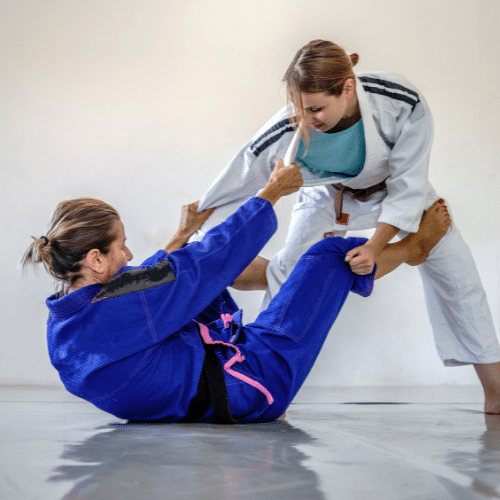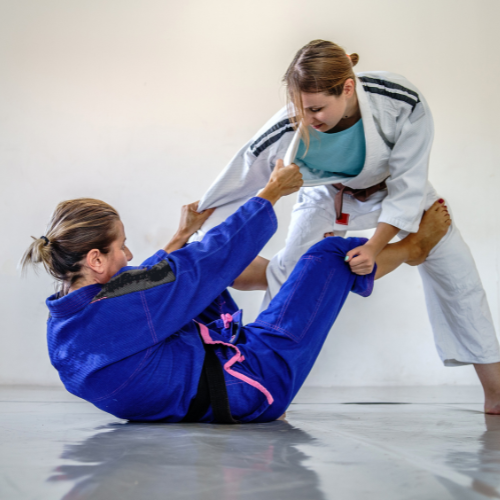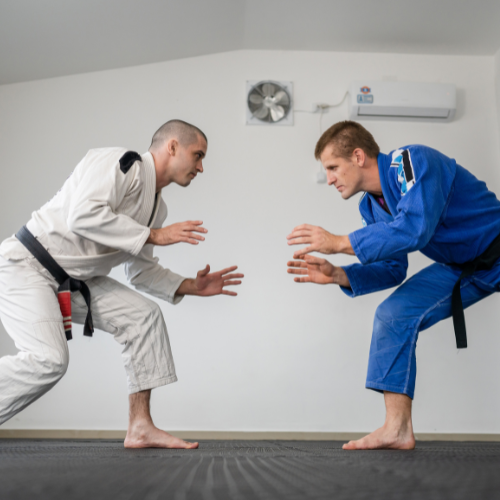

The Evolution of Jiu Jitsu Techniques: From Origins to Modern Day
Introduction
Jiu Jitsu is a martial art that originated in Japan and eventually evolved into Brazilian Jiu Jitsu (BJJ). It has a rich history that spans several centuries, with its origins dating back to the samurai warriors of feudal Japan.
Jiu Jitsu developed as a combat system for the samurai, who needed close-quarter combat techniques to use when their weapons were rendered ineffective. Over time, traditional Jiu Jitsu techniques were refined and perfected, focusing on utilizing an opponent’s energy and strength against them through joint locks, chokes, and throws.
In the early 20th century, Jiu Jitsu was introduced to Brazil by Mitsuyo Maeda, a Japanese martial artist. Maeda taught his techniques to Carlos Gracie, who then passed them on to his brothers. The Gracie family further developed and popularized the art, eventually founding Brazilian Jiu Jitsu.
Brazilian Jiu Jitsu evolved from traditional Jiu Jitsu by emphasizing ground fighting and grappling techniques. It became renowned for its effectiveness in real-life combat situations, particularly in one-on-one encounters or self-defense scenarios.
The evolution of martial arts techniques over time is not unique to Jiu Jitsu. Various martial arts styles have undergone transformations throughout history, adapting to different contexts, cultural influences, and practical needs. Through this evolution, martial arts continue to evolve and improve, providing practitioners with effective self-defense skills and physical fitness benefits.

The Early Days: Traditional Japanese Jiu Jitsu
Traditional Japanese Jiu Jitsu, also known as Jujutsu or Ju-Jitsu, originated in the early days of feudal Japan as a method of battlefield combat. It was developed by the samurai warriors as a means to defend themselves when disarmed or facing an armed opponent. This martial art focused on using the opponent’s aggression and momentum against them to neutralize their attacks.
One of the fundamental techniques of Japanese Jiu Jitsu is the art of joint locks and throws. These techniques aim to immobilize or control an opponent by manipulating their joints or throwing them off balance. This allowed the samurai to subdue and disarm their enemy while minimizing the risk of being injured themselves.
In comparison to modern practices, traditional Japanese Jiu Jitsu techniques typically relied on close-quarters combat and the use of an opponent’s strength against them. Unlike modern martial arts such as Brazilian Jiu Jitsu, which mainly focuses on ground fighting and submissions, traditional Japanese Jiu Jitsu encompassed a broader range of techniques, including strikes, kicks, and weapon usage.
Despite the evolution of martial arts over centuries, the principles of leverage, balance, and timing that were integral to traditional Japanese Jiu Jitsu have endured. Today, many modern self-defense systems and martial arts styles incorporate elements of Jiu Jitsu, acknowledging its significance in the development of effective combat techniques. While practices may have changed, the essence of traditional Japanese Jiu Jitsu remains a vital part of the martial arts landscape.
The Birth of Brazilian Jiu Jitsu
Mitsuyo Maeda’s journey from Japan to Brazil laid the foundation for the birth of Brazilian Jiu Jitsu (BJJ) and the subsequent modifications made by the Gracie family. Maeda, a renowned judoka, arrived in Brazil in 1914 and began teaching his Japanese martial art. Among his students were the Gracie brothers, Carlos and Helio, who adapted the techniques to suit their strengths and body types.
The Gracie family’s modifications primarily focused on ground fighting and submission holds, which differentiated BJJ from other martial arts. Recognizing the importance of leverage and technique over brute strength, the Gracies refined their techniques to allow smaller individuals to overcome larger opponents. Ground fighting became a central aspect of BJJ, as it provided a strategic advantage in neutralizing an opponent’s size and strength.
The Gracie family further enhanced BJJ by placing a heavy emphasis on submission holds. These techniques enable a practitioner to force an opponent into a position where they are compelled to tap out, signaling their defeat. By mastering these holds, the Gracies revolutionized the way martial arts were understood and practiced.
Through Maeda’s journey to Brazil and the subsequent adaptation by the Gracie family, Brazilian Jiu Jitsu was born. Its focus on ground fighting and submission holds made it a highly effective martial art that has since gained widespread recognition and popularity around the world.
The Technical Evolution in BJJ
The technical evolution in Brazilian Jiu-Jitsu (BJJ) has been a fascinating and impactful journey, starting from its early days in Brazil to becoming a globally recognized sport. The introduction of competitions and rulesets played a vital role in influencing the development of new techniques and strategies.
In the early days of BJJ, the focus was primarily on self-defense and the effectiveness of techniques in real-life situations. However, as competitions began to emerge, practitioners realized the importance of refining techniques to gain an advantage over their opponents. This led to the birth of a more systematic approach to BJJ, with practitioners focusing on learning and perfecting specific techniques, positions, and submissions.
The introduction of rulesets in tournaments also had a significant impact on the technical evolution of BJJ. Rulesets provided a framework within which practitioners had to operate, and this encouraged the development of new techniques and strategies that adhered to the rules. For example, the creation of weight classes led to the development of techniques and strategies specifically tailored to different weight categories.
Furthermore, the introduction of time limits and point systems in competitions brought about a shift in strategy. Practitioners started to focus on scoring points rather than solely relying on submissions, leading to the development of positional dominance and control-based strategies.
Overall, the technical evolution in BJJ has been driven by the introduction of competitions and rulesets. This has pushed practitioners to constantly innovate, refine techniques, and develop new strategies to stay ahead in the sport. As BJJ continues to gain popularity globally, its technical development shows no signs of slowing down.

The Influence of Cross-Training
Cross-training in martial arts has played a significant role in the evolution of Brazilian Jiu-Jitsu (BJJ) techniques. Martial arts practitioners from various disciplines, such as wrestling and judo, have made substantial contributions to enhancing the techniques and strategies employed in BJJ.
One notable example of influence from wrestling in BJJ is the development and adaptation of takedowns. Wrestlers brought their expertise in takedowns and takedown defense, which greatly expanded the range of techniques utilized by BJJ practitioners. As a result, BJJ players now have a wider arsenal of techniques to initiate a fight from standing position and to neutralize an opponent’s attacks.
Similarly, judo practitioners have had a profound impact on BJJ techniques. The incorporation of judo throws and sweeps into BJJ has provided grapplers with more effective ways to take an opponent down and achieve dominant positions. The judo techniques also emphasize the utilization of an opponent’s momentum and balance, allowing BJJ practitioners to exploit these elements in their own ground-based techniques.
Cross-training practitioners have not only contributed to expanding the technical repertoire of BJJ but have also influenced the strategies and approach to combat. Wrestlers, for instance, have brought a relentless pace and aggressive style to BJJ, forcing their opponents to constantly react and defend, creating opportunities for submissions. This infusion of intensity and pressure has elevated the overall level of competitiveness in BJJ.
In conclusion, cross-training from other martial arts, specifically wrestling and judo, has significantly shaped and improved BJJ techniques and strategies. The integration of wrestling takedowns and judo throws and sweeps has broadened the diverse options available to BJJ practitioners. Additionally, cross-training has brought new dynamics and styles, making Brazilian Jiu-Jitsu a more comprehensive and effective martial art.
The Role of Innovation and Experimentation
Innovation and experimentation play a crucial role in pushing the boundaries of traditional techniques within any sport, and this holds true for various activities, including martial arts. Through insight into how individual practitioners and competitors have embraced innovative approaches, new moves have been established, enhancing the sport’s overall development.
Notable innovators within martial arts have significantly contributed to the evolution of the sport. These individuals have fearlessly explored unconventional techniques to challenge the existing norms. By thinking outside the box and experimenting with different strategies, they have introduced new moves that have revolutionized the martial arts world.
Their contributions can be seen in the creation of alternative methods of attack and defense, the incorporation of acrobatics and gymnastics into fighting styles, and the development of hybrid martial arts forms. These innovators have demonstrated that by questioning traditional approaches, it is possible to uncover new possibilities and obtain a competitive edge.
Innovation and experimentation have not only expanded the repertoire of techniques but have also influenced the way martial arts are taught and practiced. They have inspired future generations of martial artists to think creatively and explore new ideas. As a result, the sport continues to evolve, adapt, and grow.
The role of innovation and experimentation within martial arts should not be underestimated. It has brought about a wave of exciting changes, propelling the sport to new heights. By highlighting the notable innovators in martial arts and their contributions, we can appreciate the impact of their brave and imaginative endeavors and encourage further exploration within the field.
The Impact of Technology and Media
The impact of technology and media, specifically the internet, instructional videos, and social media, on the spread and evolution of Brazilian Jiu-Jitsu (BJJ) techniques cannot be underestimated. These platforms have accelerated the dissemination of knowledge and facilitated learning for BJJ practitioners worldwide.
The internet has provided a vast online space where BJJ practitioners can share their knowledge and techniques. Instructional videos, particularly those available on platforms such as YouTube, have allowed practitioners to access a wealth of instructional content from renowned BJJ experts. This accessibility has led to the evolution of BJJ techniques as practitioners from different parts of the world can learn from each other’s experiences and adapt their techniques accordingly.
Moreover, social media platforms have played a significant role in fostering a global community of BJJ practitioners. Through online groups, forums, and communities, practitioners can connect with like-minded individuals, share their experiences, and learn from each other. This virtual community has created a sense of belonging and camaraderie among BJJ practitioners worldwide.
In conclusion, technology and media have had a profound impact on BJJ by accelerating the spread and evolution of techniques. The internet, instructional videos, and social media platforms have not only fostered a global community of practitioners but have also provided accessible resources for learning and sharing BJJ knowledge. These advancements have immensely contributed to the growth and development of BJJ as a martial art.
The Future of Jiu Jitsu Techniques
In contemplating the future of Jiu Jitsu techniques, it is fascinating to consider the potential influences that emerging martial arts and technology may have on the evolution of this martial art. As new martial arts are developed and gain popularity, it is likely that practitioners will be inspired to incorporate elements from these styles into their own Jiu Jitsu practice.
With the rise of mixed martial arts (MMA), for example, we have already witnessed an increased emphasis on striking and takedowns in Jiu Jitsu training. This trend may continue to develop as practitioners look to enhance their overall fighting abilities and adapt to a more dynamic and unpredictable fighting landscape.
Furthermore, technology is also likely to play a role in the future of Jiu Jitsu techniques. With the advent of virtual reality and motion capture technology, practitioners may have access to sophisticated training tools and simulations that can enhance their learning experiences. The ability to analyze movements, simulate scenarios, and receive real-time feedback could revolutionize the way techniques are taught and practiced.
However, while embracing innovation is essential for the continued growth and development of Jiu Jitsu, there is also a need to preserve traditional techniques. These core techniques embody the essence and history of the martial art, and they form the foundation upon which new techniques are built. Striking a balance between preserving tradition and embracing innovation will be critical to ensure the future evolution of Jiu Jitsu techniques remains true to its roots while also adapting to the changing times.
In conclusion, the future of Jiu Jitsu techniques is likely to be influenced by emerging martial arts and technology, as practitioners seek to enhance their skill sets and adapt to new challenges. However, it is crucial that the preservation of traditional techniques remains a priority to maintain the essence and history of this martial art.
Conclusion
In conclusion, the evolution of Jiu Jitsu techniques from its origins to modern day has been marked by numerous milestones. From its origins in Japan as feudal combat techniques, Jiu Jitsu techniques were refined and adapted by the Gracie family in Brazil, who introduced it to the world as Brazilian Jiu Jitsu. The development of new positions, submissions, and defenses revolutionized the martial art and made it highly effective for self-defense and competition.
The continuous evolution of martial arts, including Jiu Jitsu, highlights the importance of adaptation and learning. As times change and martial arts practitioners encounter new challenges, it becomes crucial to stay open-minded and embrace new techniques and strategies. Through the constant exploration and experimentation with different techniques, martial artists can improve their skills and overcome potential limitations.
BJJ, in particular, emphasizes the importance of learning from one’s mistakes and continuously pushing the boundaries of one’s abilities. By constantly refining and adapting techniques, practitioners can enhance their problem-solving skills and become more successful both on and off the mats.
In conclusion, the evolution of Jiu Jitsu techniques and the broader martial arts world is a testament to the power of adaptation and learning. Stagnation leads to stagnation, but a commitment to growth and improvement can lead to incredible advancements in both technique and mentality.
Advertisements
Granite Bay Jiu Jitsu
RELATED POSTS










